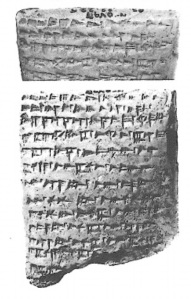A couple of weeks ago I watched the 1977 Doctor Who story Image of the Fendahl. It’s not the best example of the series, not by a long shot, but it’s lingered in my mind. Because despite the things that don’t work – the wonky pacing, the stilted performances, the fact that the monster doesn’t really do anything – there’s so much there that does. It’s bubbling with great ideas. The atmosphere is wonderfully spooky, the monsters look great when they’re not moving, even if they have nothing to do, there are some sparkling lines of dialogue. There’s an anthropologists’ dog called Leakey. I keep thinking about how you might rejig the story to really work.
 What really appeals about Image of the Fendahl is its use of palaeoanthropology. Many of the non-regulars are anthropologists, bringing novel scientific techniques to bear on extremely early human remains (or are they…) The idea of a human skull from too old a stratum that reveals a pentagram in the bone sutures when X-rayed is genuinely creepy, as is its concern with the deep time of human existence – all those long aeons before we organised ourselves into settled urban communities and started writing history. Anything could lurk in that vast span of years. What if there was something fundamentally off with humanity’s whole evolutionary process?
What really appeals about Image of the Fendahl is its use of palaeoanthropology. Many of the non-regulars are anthropologists, bringing novel scientific techniques to bear on extremely early human remains (or are they…) The idea of a human skull from too old a stratum that reveals a pentagram in the bone sutures when X-rayed is genuinely creepy, as is its concern with the deep time of human existence – all those long aeons before we organised ourselves into settled urban communities and started writing history. Anything could lurk in that vast span of years. What if there was something fundamentally off with humanity’s whole evolutionary process?
Thinking about these ideas led me to wondering about ‘anthropological horror’ as a subgenre, and whether it’s really a thing. Whether it could be. Google doesn’t turn up much. I should say now, I’m not the world’s biggest expert on horror fiction, and nor am I an anthropologist, except in the sense that any archaeologist has to dabble in the discipline to some extent. I do know Doctor Who, though, so that seems like a good place to begin looking for other examples of anthropological horror and to start to define what it is. Continue reading
 It’s time for another under-appreciated ancient monster from antiquity – or rather multiple monsters – because today we’re looking at the Devourers (ʾaklm), demons from Ugaritian mythology who faced off against Baʿal Hadad, the storm-god and patron deity of the city. Unfortunately no pictures of the Devourers exist, so I’ve had to make do with this image of Baʿal himself, on a stele from Ugarit and now in the Louvre.
It’s time for another under-appreciated ancient monster from antiquity – or rather multiple monsters – because today we’re looking at the Devourers (ʾaklm), demons from Ugaritian mythology who faced off against Baʿal Hadad, the storm-god and patron deity of the city. Unfortunately no pictures of the Devourers exist, so I’ve had to make do with this image of Baʿal himself, on a stele from Ugarit and now in the Louvre.
 The original run of Doctor Who last more than quarter of a century from 1963 to 1989 and in that time the good Doctor fought everything from the well-known Daleks and Cybermen to the more eccentric – robots made of sweets, gigantic prawn-viruses, rubber-clad men with aerials on their heads, and so on. More than once he’s come up against ancient, unknowable evils ‘Eeeevil, evilsincethedawnoftime!’ as Sylvester McCoy’s seventh Doctor once put it (unfortunately the clip doesn’t seem to be up online anywhere), and especially in the 70s, he’s also seen his fair share of sinister cultists. These are, of course, staples of the works of H. P. Lovecraft, and you’d expect a fair bit of overlap between the kinds of people who read his stories and those who watch and write for Doctor Who.
The original run of Doctor Who last more than quarter of a century from 1963 to 1989 and in that time the good Doctor fought everything from the well-known Daleks and Cybermen to the more eccentric – robots made of sweets, gigantic prawn-viruses, rubber-clad men with aerials on their heads, and so on. More than once he’s come up against ancient, unknowable evils ‘Eeeevil, evilsincethedawnoftime!’ as Sylvester McCoy’s seventh Doctor once put it (unfortunately the clip doesn’t seem to be up online anywhere), and especially in the 70s, he’s also seen his fair share of sinister cultists. These are, of course, staples of the works of H. P. Lovecraft, and you’d expect a fair bit of overlap between the kinds of people who read his stories and those who watch and write for Doctor Who.

 I wrote recently about the excellent Lovecraftian board game
I wrote recently about the excellent Lovecraftian board game